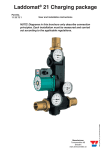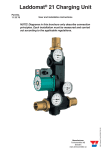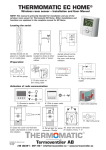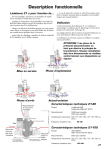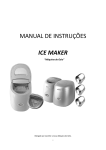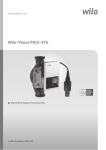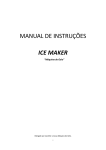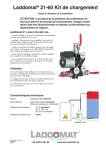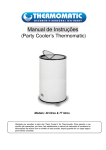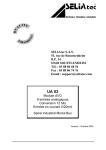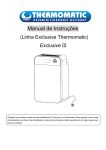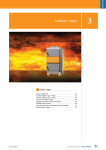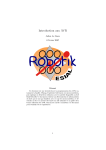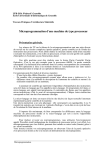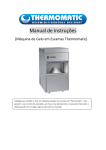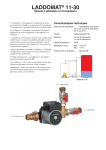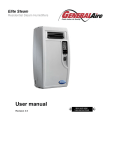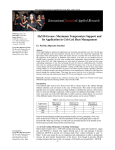Download Manual
Transcript
Description of functions Laddomat 21 is designed to... Operation ...allow the boiler to reach a high working temperature soon after firing. Laddomat 21 functions fully automatically provided that pump start and stop is automated. See page 16. ...to preheat the cold tank water in the bottom of the boiler so that the boiler does not rust away due to condensation. The settings described in this User manual are normally made only once. …charge the tank with water at a high and even temperature and low flow, to ensure optimal layering in the tank. …transfer the residual heat in the boiler to the tank after the fire has gone out. …in the event of electrical power failure stopping the pump, transfer the heat in the boiler to the tank through self-circulation. The Laddomat requires no special supervision or service. NOTE! Diagrams in this brochure only describe connection principles. Each installation must be measured and carried out according to the applicable regulations. Operating phase Start up Final phase Self-circulation Technical data Laddomat 21-60 Connection to top of boiler Pump: Laddomat LM6 Laddomat LM6A ErP 2015 Connection: 3 x Cu28 with lever 3 x R32 with lever Opening temperature: 53°, 57°, 63°, 66°, 72°, 78°, 83° or 87°C Max. boiler output: 60 kW Technical data Laddomat 21-100 Connection to bottom of boiler Connection to bottom of tank Pump: Wilo RS25-7 Wilo Yonos Para ErP 2015 Connection: 3 x R32 with lever Opening temperature: 53°, 57°, 63°, 66°, 72°, 78°, 83° or 87°C Max. boiler output: 120 kW 15 Dimensioning Generous pipe dimensions and short lengths guarantee operating reliability, even when the demand for heat is high. This also allows effective self-circulation in the event of power failure. Example: If the boiler’s nominal output is 40 kW, the max output can reach up to 60 kW. This is very important to include in the calculation when dimensioning the system. Recommended pipe dimensions for a maximum boilerto-tank distance of 2 m. Total length boiler-tank-boiler would then be 2 + 2 m + 6 bends. 1 bend is equivalent to 1 m pipe length. Connection Boiler with max output* up to: Laddomat 21-60: Place Laddomat 21 near the boiler and at the level of the boiler’s bottom output. 45 kW min. 28 Cu pipe or R25 60 kW min. 35 Cu pipe or R32 Pipe-runs must be as short as possible and have the minimum number of bends. Make sure that all air pockets are eliminated. Laddomat 21-100: 80 kW min. 35 Cu-rör alt. R32 100 kW min. 42 Cu-rör alt. R40 120 kW min. 54 Cu-rör alt. R50 Flow: At the above pipe dimensions, Laddomat 21-60 gives 2 – 3 m³/h. Laddomat 21-100 gives 3 – 4m³/h. See flow diagram below. The dimensions must be increased for longer distances. The maximum distance between boiler and tank is 6 m. Total length would then be 6 + 6 m + 6 bends. Maximum distance and self-circulation With longer distance, the Laddomat should be placed closer to the accumulator. Remember that flow capacity will decrease, both when it comes to pump flow as well as self-circulation. See example on page 6. If there are special requirements for self-circulation, the pipes must be dimensioned accordingly. Laddomat 21 must always be connected in the upright position as shown in the diagrams. The diameter of the pipe from the top of the boiler to the T-pipe and down to the Laddomat 21 must be as large as possible. This gives low water velocity, and allows air released in the boiler to separate out in the expansion chamber or the vent. Starting and stopping the charging pump The speed control on the circulation pump must be in position 3. NOTE! Check that the control is not at the lowest speed or a neutral position because this can prevent the pump from starting. The pump can be started by a flue thermostat. If extra safety is required, a water thermostat can be connected in parallel. See image to the right. Expansion vessel The expansion vessel must be sufficiently large, at least 5–10% of the total volume for an open system. If a pressure vessel is installed, this must be at least 10–20% of the total volume. Each installation must be specially dimensioned in accordance with the manufacturer’s instructions. Check that the operating pressure, when the system is cold, is never lower than the height difference between the pressure gauge and the highest radiator + 2 metre water pillar (mwp, 1 m = 0,1 bar). Radiator system To make the maximum use of the storage tank, it is very important that the radiator system is fitted with: *Boiler output: There is a difference between the nominal output and the maximum output of a boiler. The maximum output can be as much as 30-50% higher than the boiler’s nominal output. 16 1. Automatic by-pass control like Thermomatic with flow sensor and room sensor is ideal for this purpose, thanks to its ability to sense the heating needs of the house rapidly. The automatic by-pass control always matches heat output exactly to requirements. 2. Thermostatic valves with integrated pressure reduction devices, which are set to suit the radiator size. Both measures are intended to reduce the flow and so reduce the return temperature, without raising the delivery temperature. The lower the return temperature, the longer the heat in the tank lasts. Connecting to 1 tank 1. The pipe-runs shown on the diagram are optimised to minimise air-related operating interruptions. 2. The hot water pipe to the by-pass valve can be connected in two ways. A. Approx 30 cm from the top of the tank to prioritise domestic hot water. B. On the charge line connection to the tank to prioritise heating. The connection is directed downwards to prevent air rising to the radiators. Laddomat 21 can easily be reversed for right-hand mounting. Just move the thermometers to the other side. The pipe to the bottom of the tank must not be routed through the roof. This connection removes the selfcirculation function. Connecting 2 tanks The tanks must be located up against each other, and as close as possible to the boiler. The pipe-runs from the bottom of the tanks are always laid close to the floor. It is important that the flow to the tanks during charging and discharging is distributed equally. If the system is connected incorrectly, then charging will be cut off when tank 1 is full of hot water which will reach the boiler before the other tanks are completely filled. Tank 2 will be virtually unused. If the system is connected incorrectly, the warm water and the heat will run out earlier than estimated after the burner has stopped, since tank 1 will cool down more quickly than the other. If these requirements cannot be met, there are other connection options. NOTE If the radiator is connected in this way there is a large risk of heat retention in the boiler and/or reduced heat to the radiator circuit. Equal pipe lengths To achieve equal resistance, it is essential to use approximately the same pipe-lengths to the tanks, this is achieved by: 1. Connecting the charging circuit diagonally, A–A. 2. Connecting the radiator circuit diagonally, B–B. In addition, the dimension of the pipes between the tanks must be large enough to facilitate self-circulation between the tanks. It is an advantage if the tanks are connected together in the centre, to further distribute the heat. Connecting the by-pass valve The hot water port is connected at B, which prioritises hot water, or at B1, which prioritises heating. Electrical immersion heater operation When operating solely on the electrical immersion heater, it is an advantage only to heat the first tank to prevent heat loss. Shut off the other tank using the valve at the bottom of the tank. 17 Connection suggestions NOTE This type of installation will remove the selfcirculation function. The check valve must be blocked to lower the risk of keeping the boiler warm. See picture 5 on next page for instruction. Recommended installation with longer distance To make sure the charging will work, the Laddomat should be placed near the accumulator. NOTE long distance means lower flow, which means lower capacity for the system. Bottom connection of the expansion vessel gives reduced heat losses. NOTE See information on page 16 about the expansion vessel Alternative installation with open expansion vessel 18 Thermostat cartridge The thermostat cartridge is available as a spare part, and may need to be replaced more often if it is regularly exposed to temperatures close to, or above, boiling point. The number is engraved on the cartridge. See spare parts list for options Service Before carrying out any servicing work, close the three shutoffs by turning the lever on the valves at right angles to the direction of the pipe. This makes it easy to access the pump, thermal valve and check valve for service. If operating interruptions still occur, even though the system has been bled, there may be dirt such as lint, tape or thread swarf stuck in the coupling. Disassemble and clean. Clean all sealing surfaces when reassembling: Picture1 1. The thermal valve 2. The self-circulation valve 3. The pump impeller In some installations, there are problems with extremely high levels of contaminants. These can form deposits inside the pump, which may result in stoppages. Instructions for replacing the thermostat in Laddomat 21 Picture 2 Check that the pump is switched off. Close the three shut-off valves. Unscrew the cover opposite the pump. Remove the cover with the spring, plunger and thermostat from Laddomat 21. The thermostat is held in place on the plunger by an Oring. Detach the thermostat from the plunger carefully using a screwdriver (see image on right). Picture 3 Push the new thermostat into the plunger. Reinstall the cover with the spring, plunger and thermostat. Open the shut-off valves. The blocking clip is mounted here. Wait a few minutes before starting the pump to allow any air to rise and escape from the system. The installation is now ready for use. Blocking the check valve If you, for some reason, want to completely shut off the self circulation function, the check valve must be blocked. Use the blocking clip, placed at the bottom of the EPPinsulation (Picture 3), to block the check valve. The clip is then fastened around the check valve axis according to picture 5. To reach the axis, the spring needs to be removed. Laddomat 21-60 Picture 4 Picture 5 Blocking clip Laddomat 21-100 19 Installation & setting pump Laddomat LMXA Blue Green Yellow Blue Laddomat LM6A I 7-50 W 16 W II 10-50 W 34 W III 12-50 W 50 W 230 V ± 10 %, 50 Hz 20 70 73








